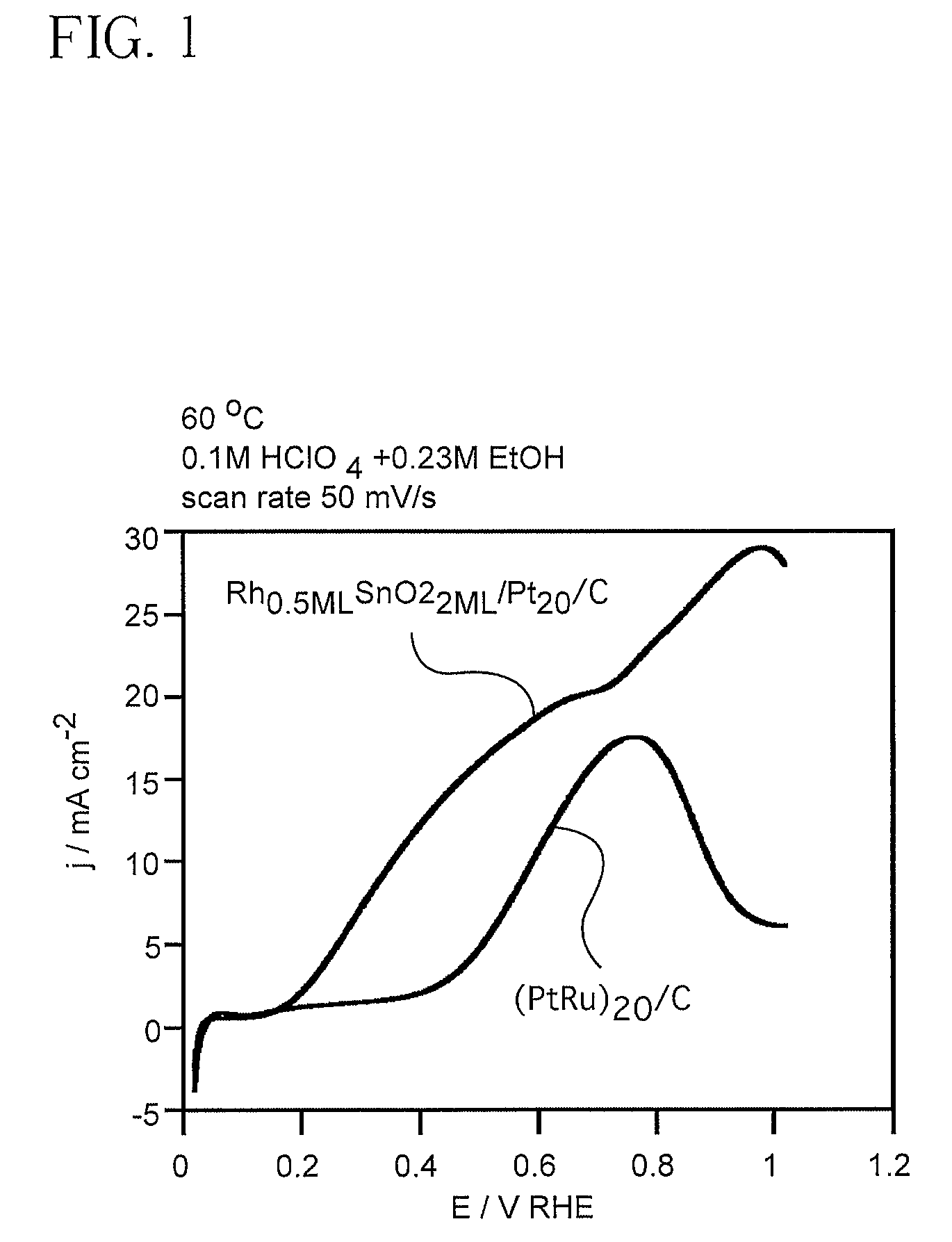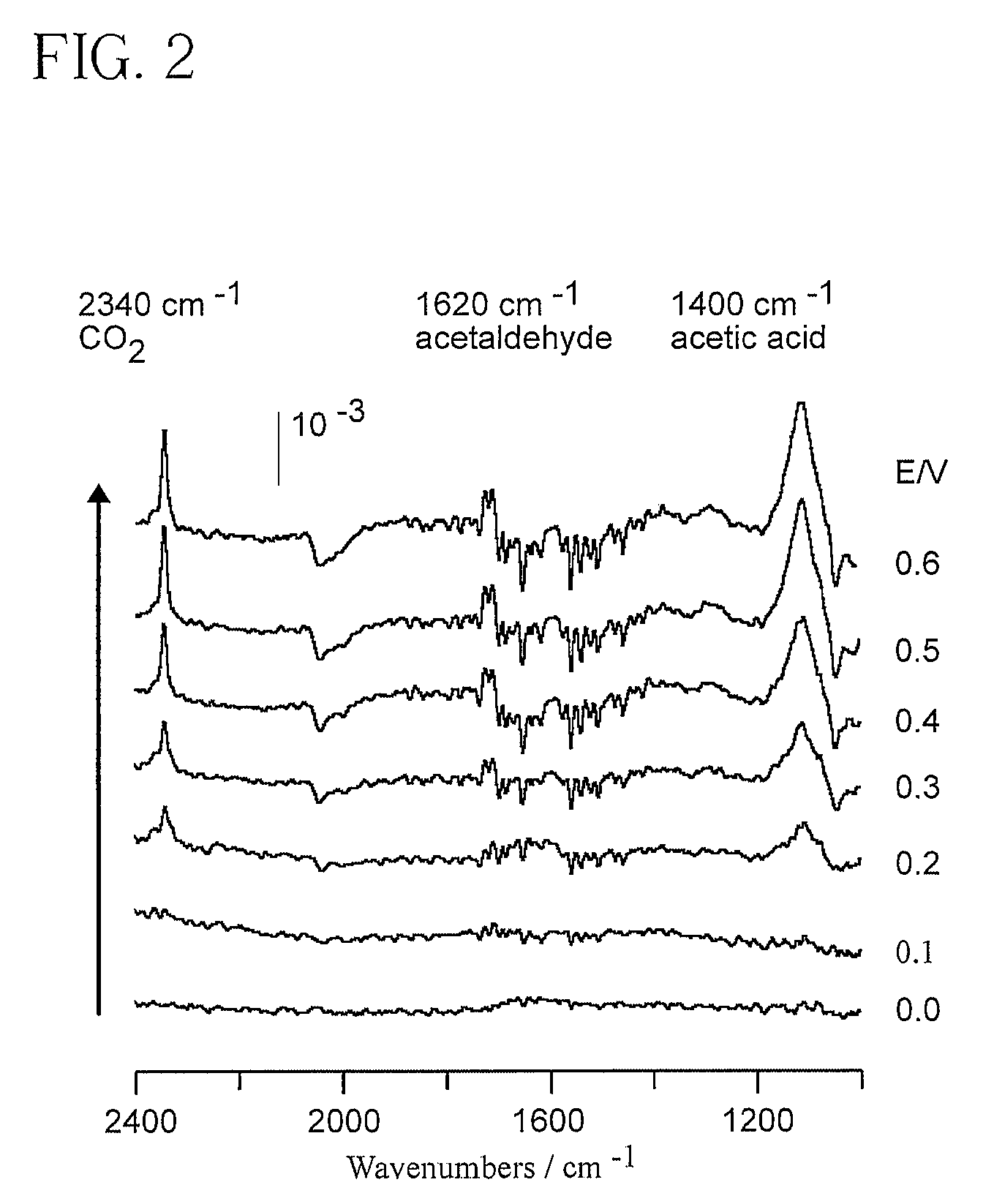Electrocatalyst for alcohol oxidation at fuel cell anodes
a fuel cell anode and electrocatalyst technology, applied in the field of electrocatalyst compositions, can solve the problems of loss of electrochemical activity of even the best electrocatalyst, accumulation of other intermediates, and the storage of hydrogen for use in fuel cells, so as to facilitate the complete oxidation of ethanol, increase the ability of the anode to oxidize alcohol fuel, and reduce carbon monoxide poisoning significantly
- Summary
- Abstract
- Description
- Claims
- Application Information
AI Technical Summary
Benefits of technology
Problems solved by technology
Method used
Image
Examples
example 1
[0056]Current-potential curves were obtained using two electrocatalysts for ethanol oxidation in an electrochemical cell. An electrocatalyst of the invention, in this case SnO2 and Rh clusters on the surface of Pt all on a carbon support (Pt / SnO2Rh / C), and a commercially available electrocatalyst, here Pt—Ru (20%), were tested for performance in an anode of an ethanol fuel cell.
[0057]Measurements were performed using a solution of 0.1M HClO4 and 0.23M ethanol at 60° C. in an all-glass electrochemical cell with a three electrode arrangement. An equal amount of Pt (150 μg / cm2) was used for the preparation of all catalysts. The approximate surface area of the catalyst was 0.28 cm2. All of the catalysts were in the form of a powder and were supported by 63% carbon (Vulcan™) and placed on a glassy carbon disk electrode and covered by a drop of dilute Nafion alcohol solution to leave a thin layer upon alcohol (ethanol) evaporation. The reference electrode was connected to the solution thr...
example 2
[0061]Current-potential curves were obtained using two electrocatalysts to oxidize ethanol at an electrode surface. An electrocatalyst of the invention, here Rh and Pt clusters on the surface of SnO2 all on a carbon support (Rh / Pt / SnO2 / C), and another electrocatalyst without Rh, Pt / SnO2 / C in this example, were tested for performance in the anode of an ethanol fuel cell. The Rh / Pt / SnO2 / C electrocatalyst contains approximately 40 mmol SnO2, 12 mmol Pt and 8 nmol Rh.
[0062]Measurements were performed using a solution of 0.1M HClO4 and 0.23M ethanol at 60° C. in an all-glass electrochemical cell with a three electrode arrangement. An equal amount of Pt (150 μg / cm2) was used for the preparation of all catalysts. The approximate surface area of the catalyst was 0.28 cm2. All of the catalysts were in the form of a powder and were supported by 63% carbon (Vulcan™) and placed on a glassy carbon disk electrode and covered by a drop of dilute Nafion alcohol solution to leave a thin layer upon a...
PUM
| Property | Measurement | Unit |
|---|---|---|
| diameter | aaaaa | aaaaa |
| diameter | aaaaa | aaaaa |
| diameter | aaaaa | aaaaa |
Abstract
Description
Claims
Application Information
 Login to View More
Login to View More - R&D
- Intellectual Property
- Life Sciences
- Materials
- Tech Scout
- Unparalleled Data Quality
- Higher Quality Content
- 60% Fewer Hallucinations
Browse by: Latest US Patents, China's latest patents, Technical Efficacy Thesaurus, Application Domain, Technology Topic, Popular Technical Reports.
© 2025 PatSnap. All rights reserved.Legal|Privacy policy|Modern Slavery Act Transparency Statement|Sitemap|About US| Contact US: help@patsnap.com



